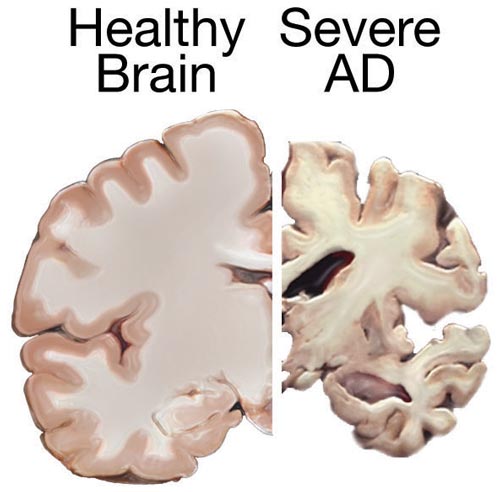Playlist
Show Playlist
Hide Playlist
Epidemiology and Risk Factors for Alzheimer Dementia
-
Slides Alzheimer Dementia.pdf
-
Download Lecture Overview
00:00 So let's talk a little bit more about Alzheimer's disease and start with the epidemiology. 00:06 Alzheimer's disease or AD is the leading cause of dementia in adults over the age of 65. It accounts for the vast majority of the cases of dementia, so it's something to know about. The incidence is greater in women than men. It is the most common type of dementia. In terms of the etiology, Alzheimer's is genetically heterogenous. 00:27 So when we think about this, we think about a combination of both genetic risk and environmental factors. Genome-wide association studies, those that look at small genes and their contribution to disease have identified over 40 single nucleotide polymorphisms, we call those snips, that are associated with Alzheimer's disease. 00:47 So there are certain genes that predisposed to Alzheimer's disease but the vast majority of patients have small gene polymorphisms that contribute to their genetic risk. Alzheimer's disease is thus considered polygenic as opposed to monogenic. 01:04 We can't go find the Alzheimer's disease gene for the vast majority of patients and multifactorial in origin. And development likely of results from a combination of underlying genetic risk in the setting of environmental factors. There are some genes that are associated with early onset Alzheimer's and our primary contributors to disease pathology, those are uncommon but the ones we see are amyloid precursor protein gene mutations. The presenilin 2 or PSEN2 gene mutations, apolipoprotein E mutations and polymorphisms can contribute to risk of developing Alzheimer's disease as well as presenilin 1. So these are genes associated with increased risk of Alzheimer's pathology on the brain and early onset of Alzheimer's disease. What are some of the other risk factors for developing Alzheimer's disease? Well, age. As we age, the incidence and prevalence of Alzheimer's disease goes up for all individuals. A family history of Alzheimer's disease increases the risk, prior head trauma or obstructive sleep apnea. This is really important. One of the long-term complications of longstanding untreated obstructive sleep apnea is the development of dementia and is one of the reasons to treat patients with OSA early. Other risk factors include diabetes, dyslipidemia, obesity, and hypertension which together form the metabolic syndrome and are important modifiable risk factors and then peripheral atherosclerosis. Such a lot of risk factors, a lot of things that increase the risk of Alzheimer's disease. How can we think about these in a way that will help us with patients in approaching clinical vignettes. Well, I'd like you to think about risk factors in terms of those that are non-modifiable and modifiable. The non-modifiable risk factors include those genetic changes; the presenilin 1 and 2, amyloid precursor protein and apolipoprotein E gene mutations. In addition, older age gender and family history are non-modifiable risk factors. We can't change our family or our age or these underlying genetic events, they are non-modifiable risks that we can stratify but don't intervene upon. 03:21 In contrast, modifiable risk factors can be managed and treated early to reduce the risk of subsequent development of dementia. So we control diabetes and dyslipidemia, obesity and hypertension. We want to manage that metabolic syndrome. In patients that have peripheral atherosclerosis, we intervene, diagnose and treat that. Alcohol consumption, smoking, and prior head trauma are also modifiable risk factors.
About the Lecture
The lecture Epidemiology and Risk Factors for Alzheimer Dementia by Roy Strowd, MD is from the course Alzheimer Dementia.
Included Quiz Questions
In patients over the age of 65, what is the leading cause of dementia?
- Alzheimer dementia
- Frontotemporal dementia
- Vascular dementia
- Parkinson's dementia
- Dementia with Lewy bodies
Alzheimer disease is known as a genetically heterogeneous disease. Which of the following are known mutations that play a role in the development of Alzheimer disease? Select all that apply.
- Apolipoprotein E gene (APOE e4)
- Presenilin 2 (PSEN2)
- TDP
- Fibrillin-1
- IDH
Which of the following are non-modifiable risk factors for the development of Alzheimer disease?
- Age
- Family History
- Smoking
- Physical activity
- Diet
Which of the following is not a major modifiable risk factor for Alzheimer disease?
- Protein intake
- Diabetes
- Hyperlipidemia
- Obstructive sleep apnea and obesity
Customer reviews
5,0 of 5 stars
| 5 Stars |
|
5 |
| 4 Stars |
|
0 |
| 3 Stars |
|
0 |
| 2 Stars |
|
0 |
| 1 Star |
|
0 |




